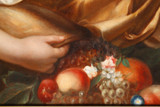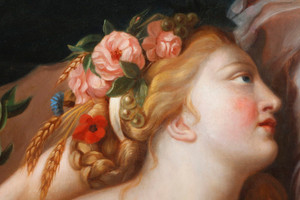

















"PEACE BRINGING ABUNDANCE", FOLLOWER OF ELISABETH VIGEE LE BRUN
Large canvas representing "La Paix ramenant l'abondance" by a follower of Élisabeth-Louise Vigée Le Brun. High-quality work produced in the late 18th or early 19th century, based on the original 1780 work in the Musée du Louvre. French school. Oil on canvas. Dimensions of the canvas (unframed) : H:98cm, W: 130cm. "Élisabeth-Louise Vigée Le Brun (1755-1842), who became a member of the Académie thanks to the support of Queen Marie-Antoinette (1774-1793), presented this painting at her reception at the Académie royale de peinture et de sculpture in 1783. The Académie's reception piece is the work by which the applicant provides proof of his talent to his peers. The allegorical subject is related to history painting, which was the noblest in the hierarchy of genres established by the Académie and traditionally reserved for men. A woman in the Académie royale de peinture et de sculpture The presence of a woman in the Académie was highly unusual in the 17th and 18th centuries. Founded in 1648 by Louis XIV, the Académie royale de peinture et de sculpture aimed to train the kingdom's finest artists. Its students and members were exclusively male, with the exception of the admission of Italian pastellist Rosalba Carriera (1675-1757) in 1720. In the society of the time, it was unthinkable for a woman to consider a professional artistic career. Drawing and painting were part of the education of girls from good families, but their practice remained limited to the private sphere. In the mid-18th century, women began to be admitted to the Académie, reflecting a change in mentality. The first female artist admitted to the Académie was Marie-Thérèse Reboul (1728-1805), in 1757. Other admissions followed, notably Adélaïde Labille-Guiard (1749-1803) in 1783. However, the admission of women to the Académie remained exceptional. Élisabeth-Louise Vigée Le Brun: fighting for equality It was against this backdrop that Élisabeth Vigée Le Brun painted her allegorical picture "La Paix ramenant l'Abondance" in 1780. Peace, dressed in a brown tunic and blue cloak, wears her traditional attributes: the laurel wreath and the olive branch. Abundance is a young blond woman, coiffed with roses and dressed in a golden drapery, holding ears of wheat alongside her traditional fruit-filled horn. The choice of subject is symbolic, with Élisabeth Vigée Le Brun proving not only her expertise in the noble historical genre, but also her ability to match her male colleagues on their own turf. Determined and endowed with great talent, she was able to assert herself, gain recognition for her work, and enjoy true status as a painter. Her struggle was part of an unprecedented movement, encouraged by Marie-Antoinette's circle: that of the professional affirmation of young women painters determined to do away with the amateurism in which the academic system kept them. Her fight for emancipation and professional equality is as relevant today as it was then. 18th century, Circa: 1790 Size: W:149cm, D:12cm, H:116cm. Re-stained painting with minor restorations and beautiful gilded wood frame.





















